|
|
Mountain/Rock |
|---|---|
|
|
43.35500°N / 42.43917°E |
|
|
18513 ft / 5643 m |
|
|
WARNING
Unless you are a Russian citizen, it is very difficult to get a visa and to travel to this region at this time. Few international flights are available. Services on the mountain have been closed to foreign travel because bank transactions between Russia and Western Countries has been suspended.
See the following link for possible updates, but for now the advice is to avoid climbing Mount Elbrus. There are plenty of other mountains in the world to climb at this time. (Note, this is a commercial link, but since it's the biggest tour operator on the mountain and based locally they usually have the most up to date information).
Updates From Pilgrim Tours
Overview
Mount Elbrus is the highest peak in Europe, and one of the Seven Summits. It's located just in Russia, though it is only a few miles/kilometers from the border of Georgia. Though Elbrus is the highest summit in Europe, it is one of the technically easiest of the higher peaks on the continent. The mountain is in the Caucasus Mountains, which is one of the most rugged mountain ranges in the world. Elbrus may not be that rugged of a mountain, but that is not the case with all the surrounding peaks! The standard route up Elbrus is long and strenuous but not technically difficult. The biggest danger is the weather which can be particularly nasty on this mountain. Besides the standard route and the northern route, there are many much more difficult routes on the mountain, though they are very seldom climbed, and little information is available.
Even though standard route on the mountain is technically easy, do not under estimate Mount Elbrus! By number of deaths, Elbrus is one of the World's deadliest mountains. Forty-eight climbers (some of which were skiers/snowboarders) died in the Mount Elbrus area in 2004 alone! HERE is a link to an interview of a person in the rescue service. In late September 2003, I found the climbing conditions to be some of the coldest and windiest that I have experienced. See TRIP REPORT.
Elbrus is an extinct volcano, having it's last eruption around 50 AD, and it's crater (300-400 meters in diameter) is now filled with ice and snow. The mountain still retains it's gently sloping, conical shape. The mountain has two main summits; the Western summit at 5642.7 meters (18,513 feet) elevation and the Eastern summit at 5621 meters (18,442 feet) elevation. The saddle between the two summits is at 5416 meters (17,769 feet) elevation.
The first ascent of the West Peak of Elbrus occured on July 1874. The climbers were F. Crauford Grove, F. Gardiner, H. Walker, A. Sottajev, and P. Knubel. The first ascent of the East Peak was in 1829 by Killar Hashirov.
POLITICAL AND OTHER IMPORTANT UPDATES!
As of January 2016, it seems that things have stabilized. Here is the latest from Pilgrim Tours.
The area surrounding Elbrus was experiencing problems from militants, but now it seems that things have gotten better.
Anyone who has updated information is free to post any additional additions and corrections to this page and I will immediately incorporate them into the page.
As of January 2016 from Pilgrim Tours concerning border permits and other updates:
1. There are still same paperwork and regulations as before:
- No National Park fee (it is absent for the last 5 years).
- Any kind of visa is ok to come the Elbrus area. Regardless what was written in your visa support (invitation) if you are in Russia you can come. Elbrus area mentioning in your voucher may be useful but definitely is not essential.
- Areas and valleys to the South from main Baksan valley are border zone (border with Georgia) and to come there one needs border zone permit. No problem to apply, no any fee but official processing for foreigners takes 2 month. This means if you want to visit those areas someone (a person or a tour operator) must apply for the border zone permit for you in a local border guard office at least 2 months in advance. Elbrus itself and the Baksan valley are not within boder zone and do not require the permit for visiting.
- Registration in the area is necessary same as in other places. There is no special regulation for Elbrus area. Normally hotels are responsible. One can do this either through hotel or tour operator.
-Migration card is essential paper. You will find this paper on a table before the passport control gates, fill it out (just 3-4 strings), show at the gates and keep it in safe place and show at the gates again when you leave Russia.
2. Because of noticeable fall of Russian Ruble which makes travelling abroad more expensive for Russians and because of new kind of fashion to travel within Russia there are (and there will be) much more Russian tourists in the area. The demand is very high and most good facilities may be fully booked in advance. Also prices in Rubles become higher. The price in USD or Euro becomes lower though.
3. There is a new leg of Elbrus line lifts. The upper station is at about 3840 meters.
There are 2 Elbrus lines. They are virtually parallel.
- The old one (3 legs): 2 legs of cable lift (one big cabin goes up and down) + 1 leg of chair lifts. The upper station of the chair lifts is at about 3700 m nearby the Barrels huts and other huts at Garabashi spot.
- The new one: there were 2 legs of cable lift (many small cabins go round) with the stations nearby old line stations. The new 3rd leg (same small cabins) goes up to about 3840 meters.
If the leg works good the 3rd leg of old lifts line will be closed.
May 30 2012from Alpinist:
The Bakson Valley has been open for skiers, climbers and tourists for the entire first half of 2012. I was there in May and never felt unsafe. We even walked to/from Cheget to Azou. Everything is calm and safe at the moment.
There are several security check points along the road from the start of the Bakson Valley all the way to Azou. They never checked our papers but I think that is because they knew our driver from Pilgrim Tours. He stopped the car once, got out and chatted with the security officers. They seemed to know each other as evidenced by their friendly man hugs. I'm not sure how complicated the drive would have been if we had been traveling independently but it was very seemless for us.
Keep updated by following the thread below:
Click Here to See Updates
Unique Photos?
Do you have a unique photo, especially one taken on a non-standard route? If so feel free to add/attach it to the mountain page. Please limit the amount of photos attached from the standard route and please limit photos that contain links to commercial advertising.
Feel free to add any photos of the standard to a personal album and then attach the album to this page.
Getting There
Now days, partially because of the red tape involved when climbing in Russia, most non-Russians will be going to Elbrus with a guided group (in the past few years it has actually become more easy than before to go independant). In that case, transportation is usually arranged before arriving in Moscow, at least if you are coming from overseas.
If you are traveling independent of a guide service, here are the directions:
Most people climbing Mount Elbrus will first arrive by plane or bus in either Mineralnye Vody or Nalchik. From either of those two locations, there are usually 4-8 buses a day headed for Terskol, but it is highly recommended that you make transportation arrangements ahead of time. This is usually easy to arrange.
From Terskol, arrange or walk the 5 kms (3 miles) up the valley and along the road to Azau at 2350 meters (7700 feet) elevation. This is where the first cable car station is, and you can’t miss it. From the cable car station, you can cheat and ride the cable cars up to the Barrels Huts (located at what is known as Garabashi Station), or you can walk. The final chairlift to the huts was closed on our visit in late September 2003, but is usually open. If it is closed you will have to walk.
The climb begins at the Barrels Huts. Make sure to acclimatize (see section below) before attempting the climb.
Notes: If you do decide to use a guiding service for the trip/climb, be aware much less expensive to go through a Russian agency as a company from the USA or Western Europe will usually charge several times more for the same service. One reliable and reasonable priced tour company is Pilgrim Tours, which is the company we used. It seems that you won't save much (if any at all) money by trying to do it on your own without a guide service, unless you really want to rough it.
Summitpost member Rybakov writes: You can take a local bus to the valley, buy local food, camp (cook your own food) and if you want to play it safe follow in the foot steps any of the many groups going up the peak. In that way it can be done much cheaper than with a company. I think I spent less than 100 Euros that way [October 2005].
Routes Overview
By far and away, the vast majority of climbers use the Standard Route via the South Face & Azau Valley. See the route page as this is only an overview. Briefly put, this route starts at either the Barrels Hut at 3900 meters (12,795 feet) or Azau Valley at 2350 meters (7,700 feet), climbs up to the Diesel Hut at 4157 meters (13,638 feet), climbs up past the Pashtuhova Rocks at 4670 meters (15,321 feet), up to the Saddle between the peaks at 5,416 meters (17,769 feet), and to the West summit at 5642.7 meters (18,513 feet). The route is pretty straight forward (Russian Grade 2B) in good weather and is usually marked with wands. There are no real crevasses provided you don't wander of the standard route. The climb can still be a trial in bad weather, so go well prepared. Total elevation gain from the Barrels hut is 1743 meters (5718 feet), and the climb usually takes 6-9 hours up. Descent usually takes 3-6 hours.
There are other routes on the mountain, but these are very seldom used. There seems to be very little information at all available.
One of the more difficult routes to Elbrus climbs the Southwest Face from Voroshilov at 2150 meters (7054 feet). That side of the mountain has many crevasses and some icefalls.
Elbrus has been climbed from the northwest and Periwal Balkbashi. No information seems to be available other than the route is quite a bit more difficult than the standard route.
Summitpost member MOCKBA has climbed Elbrus from the east. Here is an overview of his climb:
We climbed Akcheryakol Lava Flow route on the mountain's East side, largely to avoid red tape hassle which was inevitable in the Soviet times on the standard Priyut 11 approach. It was uncrowded and if slightly longer, at least this allowed more altitude adjustment time.
The trail starts from Elbrus town and followes Irikchat Gorge west towards the edge of Elbrus glacial shield and Irikchat Pass (approx. 4,000m). For altitude training, we set first camp at Irik Creek (major SW tributary of Irikchat) and climbed Terskol-Ak Mtn 3,790 South of the creek along its North-West ridge (II+ or III), then moved the camp up the main Irikchat Valley and went up 4,000+ Mount Irikchat (East Ridge, IV), and finally moved the camp to the 4,000m mark onto the lava flow, just West across Irikchat Pass.
The lava flow is a walk-up, you may luck onto some fuming hot spots there, but then you'd have to cross steep snow slopes above the rim of the East Crater and below the rock bands of the summit, in a gently ascending traverse to the left. The traverse is exposed and there may be patches of black ice near the rocks. As soon as you round the corner of the cliff bands, the slopes eases and the true summit is literally hard to find in the vast white hilly emptiness of the old crater (it is generally to your South-West).
Assuming (correctly) that nobody ever checks permissions of descending groups, we dropped towards Azau, and next day just ran all the way up Irik valley to fetch the camp gear, which is a 4 or 5 thousand feet climb so it also took a good part of a day.
SP Member Fanmount writes:
There at least three routes, not so complicated, for climbing Elbrus. Famous and most popular by South slope. Less famous, but climbed by quite a lot alpinists - by North slope. And by East - Achkoriakol Lawa Flow. If somebody need more information - come to my site or email me.
SP member Vladimir Zorin writes:
I climbed Elbrus from North side along north ridge. We started on moraine of Ullukol glacier. It is very exiting route – no people around, no traces. We could ski off the top along the route has never skied before.
Also we visited West Plateau of Elbrus. Very fantastic place!
See Photo. More information may be found HERE.
If you have climbed any other routes, please add them to the page! It would be appreciated.
Where to stay / camp in the valley
The only official place to camp in the area seems to be at the Azau Valley. There are many hotels in the valley at Terskol and Cheget. Azau has a very comfortable hotel just next to the cablecar station (see Getting There section).
Huts on the Mountain
The Barrels Huts are a group of a dozen huts (shaped like barrels of course) at 3900 meters (12,795 feet) elevation. This is normally where the climb to Elbrus begins. The huts sleep 48, but if it was really crowded, you might squeeze more in. The mountain scenery surrounding the huts is spectacular, but if you are used to seeing other huts in other places in the world (such as New Zealand or Western Europe), the site of the Barrels Huts can be a bit shocking. The place looks like an industrial complex with huge old power lines and wires all over the place. A sizable trash dump is located just east of the huts. The huts aren’t bad at all and keep out the weather, but can be cold. There are small heaters in some of the huts, but they don’t put out much heat. Our hut didn’t have a heater at all, but later we learned, some of the other people staying in a different hut took all the heaters and put them in all in their hut! There is usually running water nearby, at least in the afternoons. You must arrange these huts before heading up the mountain.
The Diesel Hut is located higher up the mountain at 4157 meters (13,638 feet) elevation. It is a newly constructed hut, made of wood, at the site of the old Pruit 11 hut, which burned down in 1999. The hut sleeps about 20, is dry inside, and the hut is in good condition. The hut has heaters, but can be cold. In the afternoons there is usually running water nearby.
One word of warning: The toilet facilities at either hut certainly rank high on the list of the world’s worst toilets. The Diesel Hut has a frozen poop fall down the side of the mountain, and it seems many people miss the hole at the outhouse at the Barrels Huts. It is highly recommended though, that everyone use these facilities to avoid polluting the mountain.
Campsites on the Mountain
Most people stay in one of the huts, but camping is still possible on the mountain. Since Elbrus is such a popular mountain, take special care not to pollute water supplies. It may be best to camp near one of the huts and use the toilet facilities.
Besides near the Barrels Hut or Diesel Hut (the most popular campsite on the mountain is just above this hut), some of the most popular places to camp are at halfway between the two cable car stations and at and area just below the second cable car station.
Environmental Issues
Bluntly put, the standard route is dirty (around the huts) and crowded and seems to be getting worse. The toilets are overflowing. The crevasses in the vicinity of the huts are used as garbage dumps. Do your best to minimize impact. Pack out all garbage. Even if gross, use the toilets.
The standard route is very crowded. July and August have the best weather, but are also the most crowded. If you are prepared, other seasons have fewer crowds as do other alternate routes.
The Caucasus have a lot more to offer than just Elbrus, so if it is remoteness and solitude you seek, this isn’t the mountain for you. If you don’t mind other climbers, Elbrus is a great mountain, but do all you can to minimize environmental impacts.
Objective Dangers
The biggest danger on Elbrus is the weather. Sudden storms and extremely cold weather are very common. Although the standard route is free from crevasses, this is not the case if you wander off route. During storms, several climbers have become disorientated, wandered off route and were never seen again. There are many frostbite and hypothermia injuries and deaths on the mountain every year.
Elbrus is high enough that altitude sickness is fairly common. See the below section.
Though the standard route is not technically difficult, climbers have been injured or killed from uncontrolled glissades. These deaths and injuries have been mostly from inexperienced climbers, and those climbers that are experienced with an ice axe and crampons will not find the standard route to be a difficult climb in good weather, though the standard route can become icy late in the season.
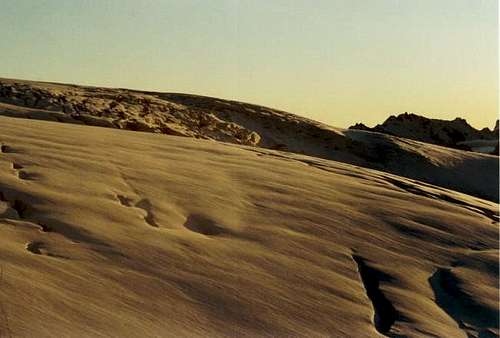 A hidden crevasse field on Elbrus. This piture was taken just after a snowstorm. Before this picture was taken, there were many highly visible and conspicuous crevasses in this field.
A hidden crevasse field on Elbrus. This piture was taken just after a snowstorm. Before this picture was taken, there were many highly visible and conspicuous crevasses in this field.Acclimatization
Mount Elbrus is a moderately high mountain, so acclimatization is very important, especially since most people will be arriving from Moscow at a very low elevation. Altitude sickness is very common on Elbrus. Preferably, at least a week should be spent at altitudes of 2500-4500 meters (8200-14,800 feet) to acclimatize before making the final ascent. Most people spend a few nights at Terskol at 2350 meters (7700 feet) altitude before taking the lift or climbing to the Barrels Huts at 3900 meters (12,800 feet). Many people also make the climb up CHEGET PEAK at about 3601 meters (11,815 feet), which is very helpful for acclimatization, not to mention the excellent views of Elbrus and the climb to come that are had from the summit of Cheget. Several nights should be spent at the Barrels or Diesel Huts [at 4157 meters (13,638 feet)] before summit day. It is recommend you use one day to climb up to at least the Pashtuhova Rocks at about 4670 meters (15,321 feet), and also that you take a rest day at the huts or at camp before summit day.
When To Climb
The normal climbing season for Elbrus is from mid-May and mid-September. The very easiest time (and the most crowded) to climb the mountain is said to be mid-July through mid-August, followed by early July and late August. September is OK too, but the weather is usually colder and the routes can become icy. In May and June, the snow is usually softer than is in July or August, and the weather is usually colder.
Elbrus has been climbed year round. In winter, expect extremely cold weather. Skiing is popular in April and May, and to a lesser extent, in the winter months.
The mountain is most crowded in July and August so there are many advantages to go outside this season. See the Environmental Issues section above.
Mountain Conditions
These are the only weather links I can find. It will be much, much cooler at higher elevations. If you know of any others, please post them as an addition/correction:
MOUNT ELBRUS WEATHER FORECAST
Below is the weather forecast for the entire region, but for low altitudes only:
REGIONAL WEATHER FORECAST
SP Member Yury writes:
You can get the most immediate information on russian forum http://www.mountain.ru/forum/ Home page is in Cycrillic. Just click on "Ïîñëàòü ñîîáùåíèå" (Send a message) URL, fill the form:
Èìÿ: = Name
E-Mail: = e-mail
Òåìà: = Subject
and press "Ïîñëàòü" (Send) button. You would get an answer in English. I recommend switchin a browser code page as:
View / Encoding / Cyrillic (Windows)
Red Tape (Visa, permits, registration etc.)
To climb Elbrus officially one must have (full list of papers):
1. Russian visa.
2. Voucher with Elbrus region mentioned.
3. OVIR registration.
4. Elbrus Area Preserve permission.
5. Immigration card.
There is way too much red tape to be discussed on this page, so please see the link below:
ELBRUS FACTS
See also THIS LINK.
It is certainly a good idea to register in rescue service in Terskol if you are not traveling with a guide service. Registering is free of charge.
Advice: To obtain a visa you will have to have a formal invitation from a tour company in Russia. Apply for your visa as far in advance as possible. We almost didn't receive ours on time because the application was returned with a minor problem with the tour company number. The Russian visa process is notoriously slow. Apply at least a few months in advance!
Books & Maps
Below are the topographic maps which are currently available for purchase in Terskol:
1. CAUCASUS: MOUNT ELBRUS REGION-Guide and maps (1:80,000 & 1:210,000) Baksan Basin - Ingur Valley-Collomb/Wielochowski
2. CAUCASUS: MOUNT ELBRUS. Map and Guide (1:50,000 & 1:1,000,000) The Upper Baksan Valley-Collomb/Wielochowski
3. CAUCASUS CENTRAL. Map and Guide (1:200,000) Elbrus to Kazbek-Collomb/Wielochowski
4. CAUCASUS BEZINGI. Map and Guide (1:100,000) Bezingi-Sugan-Laboda-Adaikhokh-Collomb/Wielochowski
Below are some highly recommended guide books:
1. Classic Climbs in the Caucasus: 80 selected climbs-Friedrich Bender, 318 pages, photos, maps. Elbrus, Ushba, Asau, Shkelda, Adyrsu, Bezingi, Publisher: Menasha Ridge Pr, ISBN 0897321162, 1 edition September 1, 1992. This is an excellent guidebook.
2. On the Edge of Europe: Mountaineering in the Caucasus-Audrey Salkeld and Jose Bermudez, 260 pages, Publisher: Mountaineers Books, ISBN 0898863880, February 1994.
3. Climbers and Hikers Guide to the Worlds Mountains-Michael Kelsey, 1248 pages, ISBN 0944510183, 2001. This is a highly recommended guidebook, and has an extensive section on climbing in the Caucasus. There is also a lengthy discussion about travel in Russia, including visas, independent travel, etc.
External Links
- Climbing Elbrus
Vladimir Kopylov's website for organizing commercial climbing, hiking & heliskiing expeditions in the Elbrus region of Caucasus range. - Swedish Elbrus expedition planning help
How to get to the summit and how to get to elbrus - Pilgrim Tours
A Russian adventure travel service company.


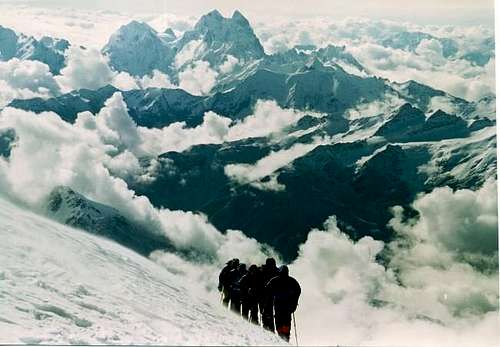
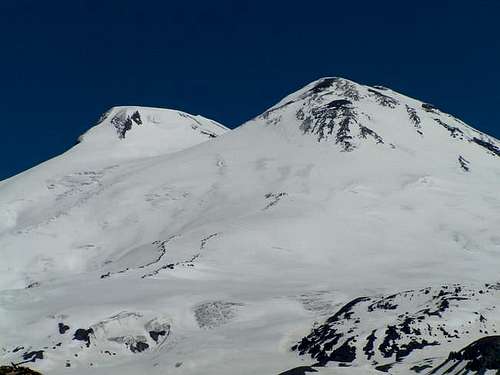

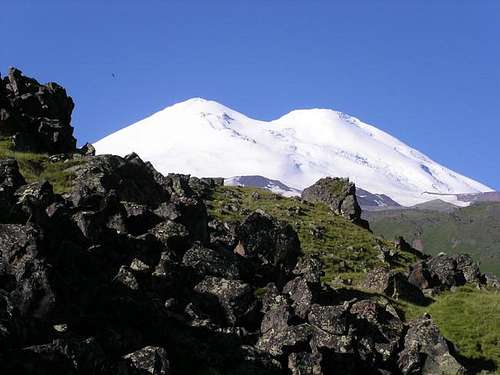
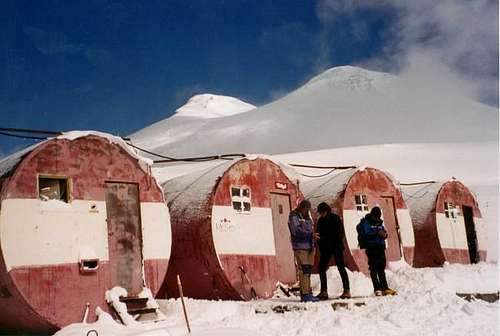
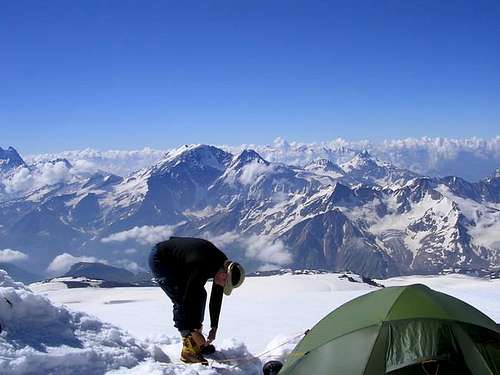
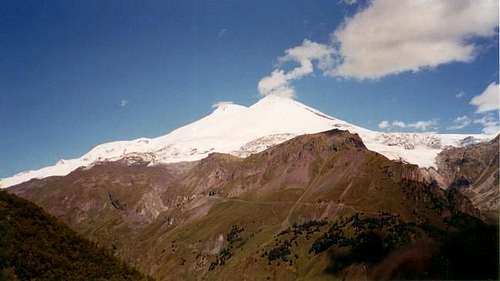
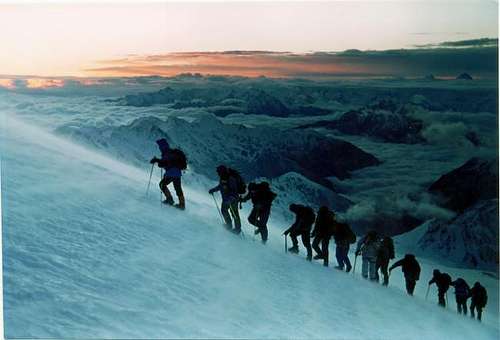
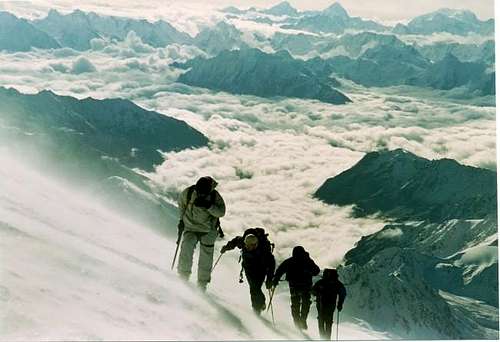
jck - Nov 29, 2015 5:03 pm - Hasn't voted
Eastern routeI climbed Elbrus (West summit) along eastern route. A short video from the trip, based on GPS track and Google Earth. Might be useful. https://m.youtube.com/watch?v=sUBEooLCzuI
Hegyibarom - Jan 2, 2016 11:25 am - Hasn't voted
Normal route - SoloVideo from the standard route - alone without any support or help during the climb: https://www.youtube.com/watch?v=fuO4Ha-MjAU
wtellis7 - Jun 8, 2018 8:33 pm - Hasn't voted
Re: Normal route - SoloHello I was wondering if this was your video and if you were willing to break down the particulars of your trip. I want to solo Elbrus next year and wanted to know the practicality given my current skills and experience.
InformElbrus - Jul 3, 2017 2:31 am - Hasn't voted
Elbrus todaySmall corrections: the height of the western peak of Mount Elbrus is 5642 m. Permit for being in the national park 50 rubles for the whole period of stay, is paid to the employee of the park on the route. Page of the tourist information center in Treskol (information support and assistance, accommodation, mountain shelters, local guides, transfer): https://www.facebook.com/InformElbrus/ my.freeride@mail.ru Will be useful to those who do not use the services Travel agencies.
Wandering Yooper - Apr 10, 2021 10:21 am - Hasn't voted
Northwest Route ProjectI am part of a team working on a project to provide better access to the NW Face of Elbrus for foreign climbers. Read about this project at https://elbrus4alpinists.org. Please email me with any questions or if you think that you can assist the project team in any way.